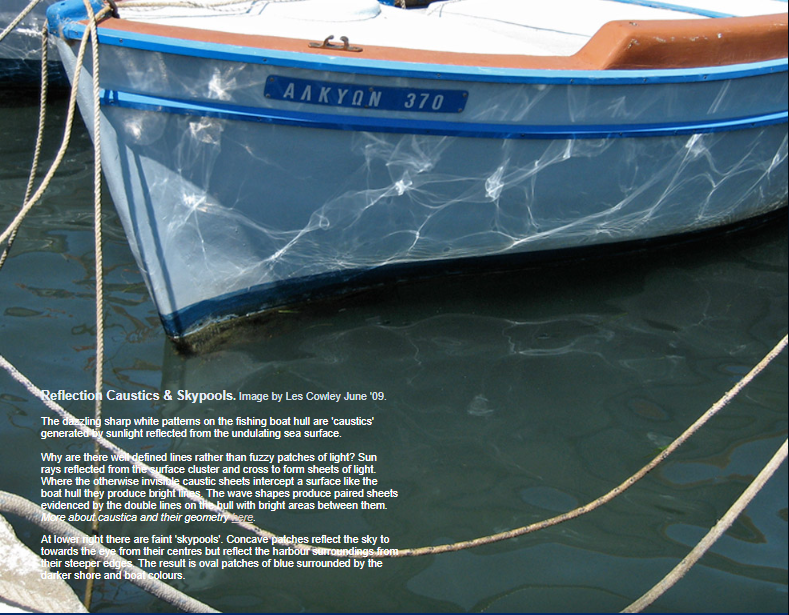Reflection Caustics
Reflection Caustics: A Phenomenon of Dazzling Patterns
Reflection caustics, also known as skypools, are mesmerizing optical phenomena that occur when sunlight reflects off the undulating surface of the sea. These phenomena manifest as sharp white patterns, forming well-defined lines rather than fuzzy patches of light. But why do these lines appear so distinct and precise?
The answer lies in the way sun rays reflect from the surface and cluster together, crossing one another to form sheets of light. These sheets of light, called caustics, are usually invisible but become visible when they intercept a surface such as the hull of a boat. When caustic sheets meet the boat's hull, they create bright lines that stand out against the background.
The geometry of caustics is fascinating. The undulating waves on the sea's surface give rise to paired sheets of light, which are evident from the double lines observed on the boat's hull. The bright areas between these double lines result from the interaction of sunlight with the wave shapes. It is this intricate interplay between light and water that produces the captivating phenomenon of reflection caustics.
However, reflection caustics are not the only optical marvel visible in the image. In the lower right corner, we can observe faint skypools. Skypools are concave patches on the water's surface that reflect the sky towards the observer from their centers. However, from their steeper edges, they reflect the surroundings of the harbor. This interplay between different angles of reflection gives rise to oval patches of blue surrounded by darker shore and boat colors.
The presence of skypools adds another layer of complexity to the overall scene. These oval patches of blue provide a stark contrast to their surroundings, creating a visually striking effect. The interaction between the sky and the harbor surroundings, as reflected by the skypools, adds depth and dimension to the composition.
In conclusion, reflection caustics and skypools are captivating atmospheric optics phenomena that arise from the interplay of sunlight, water waves, and reflective surfaces. The distinct lines of caustics result from the clustering and crossing of sun rays, while skypools form oval patches of blue through the varying angles of reflection. These phenomena showcase the beauty and complexity of nature's interaction with light, leaving us in awe of the intricate patterns that can be observed in our everyday surroundings.

Reflection Caustics & Skypools. Image by Les Cowley June '09.
The dazzling sharp white patterns on the fishing boat hull are 'caustics' generated by sunlight reflected from the undulating sea surface.
Why are there well defined lines rather than fuzzy patches of light? Sun rays reflected from the surface cluster and cross to form sheets of light. Where the otherwise invisible caustic sheets intercept a surface like the boat hull they produce bright lines. The wave shapes produce paired sheets evidenced by the double lines on the hull with bright areas between them. More about caustica and their geometry here.
At lower right there are faint 'skypools'. Concave patches reflect the sky to towards the eye from their centres but reflect the harbour surroundings from their steeper edges. The result is oval patches of blue surrounded by the darker shore and boat colours.
Note: this article has been automatically converted from the old site and may not appear as intended. You can find the original article here.
Reference Atmospheric Optics
If you use any of the definitions, information, or data presented on Atmospheric Optics, please copy the link or reference below to properly credit us as the reference source. Thank you!
-
<a href="https://atoptics.co.uk/blog/reflection-caustics/">Reflection Caustics</a>
-
"Reflection Caustics". Atmospheric Optics. Accessed on November 26, 2024. https://atoptics.co.uk/blog/reflection-caustics/.
-
"Reflection Caustics". Atmospheric Optics, https://atoptics.co.uk/blog/reflection-caustics/. Accessed 26 November, 2024
-
Reflection Caustics. Atmospheric Optics. Retrieved from https://atoptics.co.uk/blog/reflection-caustics/.